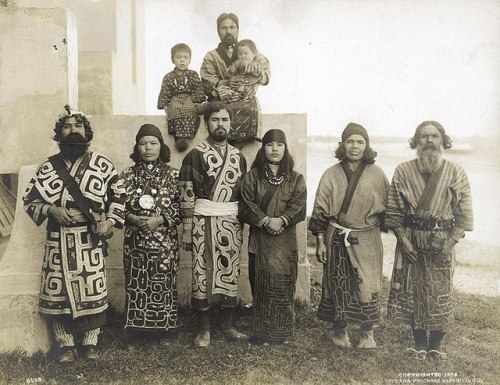Ainu people (click to enlarge)1. Ainu men, Japan by Felice Beato, 1860-70 (click to enlarge)2. Ainu
Ainu people (click to enlarge)1. Ainu men, Japan by Felice Beato, 1860-70 (click to enlarge)2. Ainu and Japanese, 19043. Ainu c. 18704. Ainu couple, 19145. Ainu house6. Ainu house interior7. Ainu man, ca. 18808. Traditional Ainu clothes of Hokkaido9. Ainu man, Hokkaido island by Alexander Khimushin10. Ainu woman playing a tonkori11. Ainu woman with mouth tattoos and live bear12. Sakhalin Ainu men, photographed by Bronisław Piłsudski13. Group of Ainu, 1904The Ainu or the Aynu (Ainu アィヌ Аину Aynu; Japanese: アイヌ Ainu; Russian: Айны Ajny), in the historical Japanese texts the Ezo(蝦夷), are an indigenous people of Japan (Hokkaido, and formerly northeastern Honshu) and Russia (Sakhalin, the Kuril Islands, and the Kamchatka Peninsula).[5]The official estimated number of the Ainu is 25,000, but unofficially the number is estimated at 200,000, as many Ainu have been completely assimilated into Japanese society and have no knowledge of their ancestry.The Encyclopedia Britannica of 1911 states,Traditional Ainu culture was quite different from Japanese culture. Never shaving after a certain age, the men had full beards and moustaches. Men and women alike cut their hair level with the shoulders at the sides of the head, trimmed semicircularly behind. The women tattooed their mouths, and sometimes the forearms. The mouth tattoos were started at a young age with a small spot on the upper lip, gradually increasing with size. The soot deposited on a pot hung over a fire of birch bark was used for colour. Their traditional dress was a robe spun from the inner bark of the elm tree, called attusi or attush. Various styles were made, and consisted generally of a simple short robe with straight sleeves, which was folded around the body, and tied with a band about the waist. The sleeves ended at the wrist or forearm and the length generally was to the calves. Women also wore an undergarment of Japanese cloth.Modern craftswomen weave and embroider traditional garments that command very high prices. In winter the skins of animals were worn, with leggings of deerskin and in Sakhalin, boots were made from the skin of dogs or salmon. Ainu culture considers earrings, traditionally made from grapevines, to be gender neutral. Women also wear a beaded necklace called a tamasay. -- source link
Tumblr Blog : sartorialadventure.tumblr.com
#fashion#ainu#ainu fashion#japan#japanese fashion









